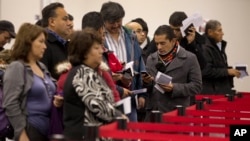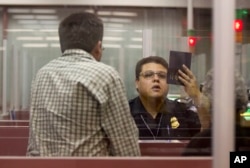As the White House mulls new travel restrictions on countries with high visa overstay rates, activists say African asylum-seekers may feel the consequences.
The Wall Street Journal reported recently that the Trump administration was weighing rules aimed at nationals of countries with high overstay rates of business and tourism visas, known as B1s or B2s.
According to the newspaper, the United States would warn countries to cut the overstay rates or see future visas harder to obtain and set for shorter periods. Such rules could be implemented soon through a presidential proclamation, a Department of Homeland Security (DHS) official told the political website Politico.
That means the nations with the highest rates of travelers overstaying their visas, rather than the ones that have the highest number overall, would feel the most impact of any new rules. African nations like Djibouti, Eritrea, Chad, Liberia, Somalia, Burkina Faso, South Sudan and Sudan are among those with the highest rates.
By comparison, only one African nation — Nigeria — is among the top 10 worldwide for most overstays overall, including both Visa Waiver Program (VWP) and non-VWP countries. The waiver program allows citizens of certain nations to visit the United States for up to 90 days without a visa.
Canada, Mexico, Brazil, Venezuela, the United Kingdom, Colombia, Nigeria, China, France and India each have higher totals than the 17 countries with the highest overstay rates combined, according to a VOA analysis of fiscal year 2017 DHS statistics.
VOA sent written questions requesting the outlines of the proposed restrictions and a list of countries likely to be affected to DHS and the White House but received no response.
"The government has chosen to focus on rates versus numbers because it fits their narrative that all immigrants are poor and brown or black," Samah Mcgona Sisay, Equal Justice Works Fellow at New York-based rights group African Services Committee, said in an interview with VOA.
Although B1s and B2s are temporary, nonimmigrant visitor visas — carrying strict guidelines, a lengthy application process and a $160 price tag for visitors from non-VWP countries — the proposed restrictions would target individuals legally seeking asylum, Sisay said, like many of her clients.
"The rates are high because oftentimes … a visa is their only way to get out of the country," Sisay said.
Black immigrants 'in the bull's-eye'
Last September, a proposed "public charge" regulation was unveiled by DHS aimed at making it harder for would-be legal immigrants to qualify for permanent residency if deemed likely to use public benefits. Under current law, legal permanent residents generally do not qualify for federal public benefits for their first five years of living in the U.S.
Separately, the Reuters news agency reported immigrant visa denials have increased due to a recent rule change allowing U.S. State Department officials greater discretion on public charge grounds.
These factors, combined with recently reintroduced legislation to cut family-based immigration and eliminate the diversity visa lottery — all in the midst of a major personnel shake-up at DHS — have added to growing uncertainty for black immigrant communities in the U.S., said Carl Hamad-Lipscombe, deputy director of the Black Alliance for Just Immigration.
"They know that they are in the bull's-eye," Hamad-Lipscombe said. "This administration is not interested in exploring additional pathways for lawful entry to the U.S., but they're also considering cutting the few pathways that immigrants — and particularly immigrants from African countries — have."
WATCH: High Visa Overstay Rates Linked to Immigration Policies
"You could bring a claim based on discrimination and say that [the overstay] rule change ... is arbitrary and actually based on discrimination," Sisay added.
Last year, President Donald Trump reportedly used an expletive to refer to African nations and Haiti during a closed-door immigration meeting with lawmakers.
Why target visa overstays now?
Over the past two years, the administration's immigration policies have largely emphasized security measures on the U.S. southern border with Mexico.
There have been notable exceptions: they include Trump's Supreme Court-upheld travel ban, which imposes restrictions on foreign nationals from five Muslim-majority countries, including Somalia and Libya, and a record-low refugee cap set by the administration.
White House spokesman Hogan Gidley told the Journal the administration considers it a priority to tackle visa overstays "to protect American taxpayers."
But visa overstays, representing 62% of additions to the undocumented population in 2016, have outpaced entries without inspection (EWIs) for the last decade and are "not a new phenomenon," said Robert Warren, senior visiting fellow at the Center for Migration Studies of New York.
Any proposed fix, Warren said, should fall on the U.S., in the form of greater resources for visa-issuing offices — "the first line of defense against overstaying" — and preventing tourists from gaining employment.
"It's inconceivable that a foreign country can have any influence over whether or not their nationals overstay here, after they come here as tourists," Warren told VOA.
In September, U.S. Customs and Border Protection (CBP) noted "considerable progress" in implementing a biometric entry and exit system to track air travelers, although the technology remains in a pilot phase.
The Trump administration's proposed cuts to the State Department's fiscal 2020 budget, combined with its decision to close offices of the U.S. Citizenship and Immigration Services (USCIS) abroad and transfer those duties to embassies and consulates, could further strain the department's resources.
Questioned about the proposed budget, a State Department official told VOA, "Our first priority when adjudicating visa applications is to ensure that applicants do not pose a security risk to the United States."
On the USCIS closures, the official added, "We anticipate a smooth transition and continued efficient processing of USCIS-related work at all of our missions overseas."














